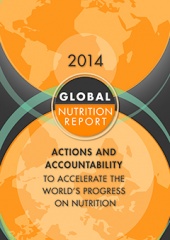Malnutrition affects one in two people on the planet. 165 million children under the age of five suffer from stunting, while two billion people are deficient in one or more essential micronutrients, such as vitamin A, zinc, and iron. Meanwhile, 1.5 billion people are classified as overweight or obese. The costs of failing to address malnutrition are tragically high: premature death, stressed health systems, and a severe drag on economic progress.
Against this backdrop, the first-ever Global Nutrition Report (GNR) has been launched. The report, which was conceived at the 2013 Nutrition for Growth Summit in London, provides a comprehensive narrative on global and country-level progress in nutrition and its drivers for the 193 member states of the United Nations. An independent expert group that authored the GNR used data that cover all forms of malnutrition, from undernutrition in young children to nutrition-related noncommunicable diseases in adults, and from stunting to obesity.
The report authors observe that malnutrition affects virtually every country in the world, regardless of geography or economy. For the 122 countries with comparable data, all except two experience at least one of three common forms of malnutrition: under-five stunting, anemia among women of reproductive age, or adult overweight.
Moreover, the world is not on track to improve this situation—falling far behind on the 2012 World Health Assembly (WHA) indicators and global targets on accountability for reducing malnutrition. For example, although there has been progress in reducing under-five stunting rates, only 22 of the 109 countries with available data are on course to meet the reduction target. Elsewhere, only five of 185 countries with data on anemia among women of reproductive age are on course to meet the reduction target.
Nevertheless, investments in nutrition are encouraging. The authors reported advances made against the financial commitments put forth by the 2013 Nutrition for Growth Summit signatories. Where it was possible to assess progress, the vast majority of countries, civil society organizations, businesses, UN agencies, and donors who jointly committed to increase investment in nutrition were “on course” to meet their commitments. Additionally, funding from international partners is increasing: between 2010 and 2012, disbursements from major donors to nutrition programs increased by 20 percent, from US$1.26 billion to US$1.52 billion. Although substantial, the jump remains small in relation to overall official development assistance spending, which remains at just over 1 percent.
The report gives national governments a mixed grade, finding that government expenditures for nutrition-sensitive programs in key sectors—agriculture, education, health, and social protection—vary between and within regions. For example, social protection spending is increasing rapidly in many African and Asian countries, which is promising for efforts aimed at scaling up nutrition-sensitive actions.
The authors conclude with a series of recommendations:
- In the absence of a “magic bullet,” global alliances including a wide range of stakeholders are required over a sustained period to generate substantial improvements in nutritional status at the national level;
- Investments in human infrastructure should be encouraged, as they yield benefits—such as improved productivity—that compare favorably with other infrastructure-based investments;
- In order to scale up nutrition interventions, capacity also must be scaled up. This encompasses hiring and motivating sufficient frontline nutrition staff, equipping clinics, and investing in infrastructure; and
- The share of nutrition-sensitive investments in agriculture, social protection, water, sanitation and hygiene, education, and women’s empowerment programs needs to expand in order to reach nutrition targets.
The key challenge behind such widespread efforts, however, is accountability, which the authors underscore must be strengthened across the board. They also note that relying on coordinated actions across sectors–none of which makes nutrition its primary goal–allows policymakers to avoid responsibility. To counter this, they suggest three areas for improved accountability and leadership:
- For the new set of Sustainable Development Goals (SDGs) for 2030 under development, more nutrition indicators need to be embedded throughout the framework, and the nutrition community needs to intensify its engagement with the process to ensure that more ambitious SDGs targets are set;
- At the national level, laws, policies, and charters must be put in place as an infrastructure for accountability among nutrition stakeholders, including self-evaluation processes for Scaling Up Nutrition member governments and monitoring efforts by civil society; and
- Filling data gaps—for example, only 60 percent of the 193 member states of the UN have the data to assess whether they are on course to meet global WHA targets—will advance the scaling up of nutrition-based inventions.







